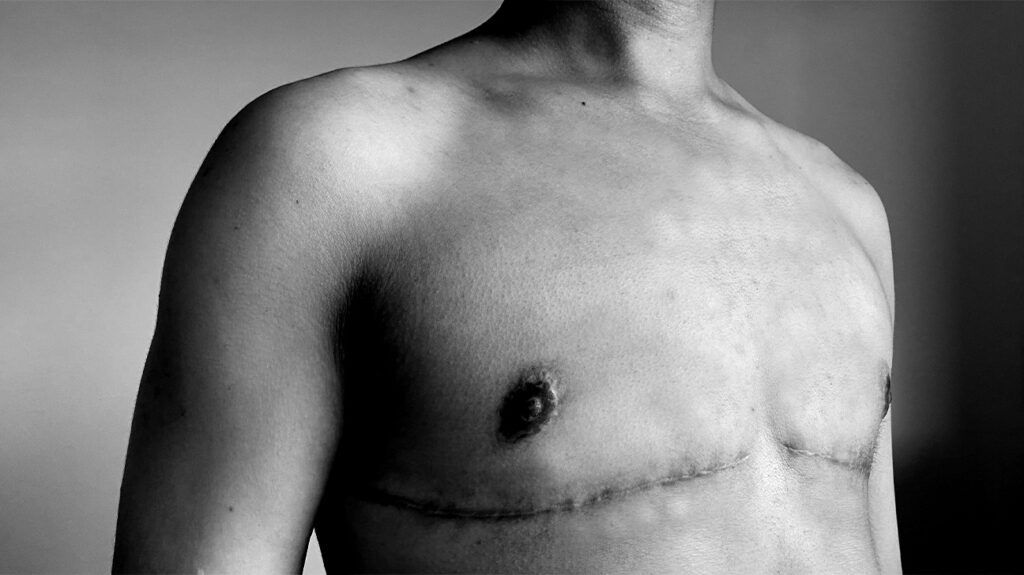Top surgery will cause some scarring, which varies depending on the type of surgery people have. Maintaining good health before and after surgery and proper wound care postsurgery may help to minimize scarring.
Top surgery can cause scars around the chest and areola area, which may look different depending on the type of surgery people have and how each individual heals.
This article examines the types of scarring that may occur with top surgery.
It also offers tips for promoting wound healing and minimizing scarring.

All types of top surgery may leave some scarring, but the type of scarring people have after surgery may depend on their specific procedure.
Double incision
A double incision procedure may result in larger, more significant scarring than other procedures.
This procedure will leave a scar running horizontally underneath the chest, or pectoralis, muscles. People may also have a scar around the areola due to the incision for a nipple graft.
Keyhole
Keyhole surgery involves a small incision across the bottom of the areola, the pigmented skin around the nipple. This type of surgery may create a small scar near the areola.
According to an older 2017 article, keyhole top surgery may produce scarring that is barely visible, in contrast to double incision surgery. Researchers found keyhole top surgery had a higher aesthetic rating than a double incision procedure.
Periareolar
Periareolar surgery creates a circular incision around the areola. It can leave a scar around the areola.
The periareolar technique creates
There are certain steps people can take before surgery that may help support the healing process and minimize the appearance of scars. These include maintaining good overall health and avoiding smoking at least 4 to 6 weeks before and after surgery. Smoking
Eating a balanced diet containing vegetables, fruits, protein, and wholegrains may also help. To promote wound healing, the Academy of Nutrition and Dietetics suggests:
- ensuring enough protein intake by including a source of protein with each meal or snack throughout the day, such as eggs, dairy, beans, or fish
- eating foods high in vitamin C, such as strawberries and broccoli
- eating foods high in zinc, such as seafood, fortified grains, chicken, or beef
- staying well-hydrated
People can discuss postsurgery wound care with their healthcare team and how it may help to minimize scarring. This may include:
- following all wound care instructions from the surgeon
- applying compression or continuous pressure to a wound with a compression garment or bandage or silicone sheet to help flatten any scarring
- after the appropriate healing period, gently massaging the scar to prevent the buildup of scar tissue
- applying a silicone sheet or gel to the scar to help hydrate it
- protecting the scar from the sun to help minimize discoloration and help the scar fade after a wound has healed
If there are any problems with the wound healing process, there
Hypertrophic scars are thick, raised scars. Keloid scars are raised scars that grow beyond the area of the original wound.
What factors can contribute to a person more likely to develop visible scarring?
The extent of scarring can depend on the type of surgery people have and how each individual heals, but other factors may also contribute to more visible scarring.
Hypertrophic and keloid scars are raised scars that may be more visible. Risk factors for hypertrophic and keloid scars
- high blood pressure
- systemic inflammation
- infection
- genetics
Other factors that may affect how a scar appears include:
- skin color, as keloid scars are more common in people with dark skin
- age
- sex
Various scar treatments may help to reduce atypical scarring postsurgery. Treatments help to reduce or camouflage the appearance of a scar or create a new, less visible scar.
Medical tattooing
A medical tattoo artist can tattoo the scar to camouflage it with the surrounding skin in order to make it less visible. The tattoo artist will match pigments with the surrounding skin tone so that the scar blends into the skin.
Scar revision surgery
Scar revision is a surgical procedure to reposition or alter a scar to make it less noticeable than the previous scar. This surgery may involve removing the area of scar tissue and placing a skin flap or graft to replace the scar.
The overall healing time for top surgery may depend on the type of surgery, but it can take up to 8 weeks.
People may need to restrict certain movements during the recovery period and avoid any heavy lifting or strenuous exercise. This can help the healing process and reduce scarring.
Do scars from top surgery go away?
Scarring from top surgery can reduce and fade over time, but they may not disappear completely.
Is it possible to get top surgery without scars?
Top surgery will cause some scarring, but the extent and type of scarring can depend on the type of surgical procedure people have.
Keyhole and periareolar techniques may cause smaller, less noticeable scars than double incision surgery. There are also treatments to help minimize or disguise scars after surgery.
Should a person massage top surgery scars?
Massaging a scar after it has healed may help keep the scar supple and reduce the formation of scar tissue.
Top surgery will cause some scarring, but the type of scar will depend on the surgical procedure people have.
Keyhole and periareolar techniques may create smaller, less visible scarring than double incision surgery.
Proper wound care and maintaining good health before and after surgery may help to minimize scarring. Scar treatments can also help alter the appearance of a scar postsurgery.
